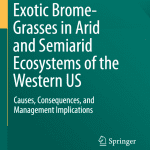Research and Publications
View fact sheet, pg. 43.
This fact sheet defines Great Basin wildland fuels and reviews some of the approaches used to assess fuel loads in Great Basin ecosystems.
View all topics reviewed in the Fact Sheet series.
View fact sheet, pg. 28.
This fact sheet aim introduces the basic patterns, concepts, and terminology of wind erosion and provides a basic framework for erosion risk assessment and response.
View all topics reviewed in the Fact Sheet series.
View fact sheet, pg. 60.
This fact sheet provides land managers with information that can help identify different aspen types, assess the condition of aspen stands, and prioritize stands for restoration using appropriate treatments.
View all topics reviewed in the Fact Sheet series.
View fact sheet, pg 49.
This fact sheet provides land managers with state-of-the-art information on the establishment of big sagebrush through direct seeding.
View all topics reviewed in the Fact Sheet series.
View fact sheet, pg. 54.
This fact sheet provides an overview of the immediate and short-term hydrologic impacts of fire on infiltration, runoff, and erosion by water, and of the effectiveness of various mitigation treatments in the reduction of runoff and erosion in the years following the fire.
View all topics reviewed in the Fact Sheet series.
View fact sheet, pg. 68.
This fact sheet discusses consequences and options for woody plant fuel reduction in Wyoming big sagebrush plant communities of the Intermountain West.
View all topics reviewed in the Fact Sheet series.
View fact sheet, pg. 74.
Great Basin sagebrush communities are experiencing widespread degradation due to the introduction of invasive annual weeds and disturbances that promote weed expansion, including inappropriate grazing and fire. Many sites previously occupied by diverse communities of perennial grasses, forbs, and shrubs have been reduced to depauperate sagebrush stands that readily become dominated by invasive annuals following fire. Post-fire seeding may be necessary to prevent these areas from converting to annual grasslands.
View all topics reviewed in the Fact Sheet series.
Individual fact sheets comprising the Information and tools to conserve and restore Great Basin ecosystems – Factsheet Series are available below.
No. 1- Putting resilience and resistance into practice
No. 2- Limiting medusahead invasion and impacts in the Great Basin
No. 4- Conifer removal in the sagebrush steppe: The why, when, where, and how
No. 6- Wind erosion following wildfire in Great Basin ecosystems
No. 7- Post-fire grazing management in the Great Basin
No. 8- Establishing big sagebrush and other shrubs from planting stock
No. 9- Assessing fuel loads in sagebrush steppe and PJ woodlands
No. 10- Seeding big sagebrush successfully on Intermountain rangelands
No. 11- Assessing impacts of fire and post-fire mitigation on runoff and erosion from rangelands
No. 12- Management of aspen in a changing environment
No. 13- Woody fuels reduction in Wyoming big sagebrush communities
No. 14- Seeding techniques for sagebrush community restoration after fire

The book, Exotic brome-grasses in arid and semiarid ecosystems of the western US: causes, consequences, and management implications, is presented in several chapters.
Access is provided for the following chapters -
Chapter 1 - Introduction: Exotic annual Bromus in the western USA
Chapter 2 - Exotic annual Bromus invasions: comparisons among species and ecoregions in the western US
Chapter 3 - Ecosystem impacts of exotic annual invaders in the genus Bromus
Chapter 7 - Community ecology of fungal pathogens on Bromus tectorum
Chapter 8 - Soil moisture and biogeochemical factors influence the distribution of annual Bromus species
Chapter 9 - Bromus response to climate and projected changes with climate change
Chapter 10 - Plant community resistance to invasion by Bromus species: The roles of community attributes, Bromus interactions with plant communities, and Bromus traits
Chapter 11 - Land uses, fire, and invasion: Exotic annual Bromus and human dimensions
Chapter 12 - Assessing restoration and management needs for ecosystems invaded by exotic annual Bromus species
View fact sheet.
It is likely that increasing temperatures will stress native sagebrush steppe species in the lowest, hottest basins more than in cooler and wetter upland habitats. Second, the effect of climate change on cheatgrass and fire is critical but uncertain. Regional warming will increase the frequency of hot, dry conditions that promote fire, but droughts could dampen the fire cycle by limiting the production of fine fuels. Third, the adaptive capacity of sagebrush is unknown and research on the potential for sagebrush to adapt to climate change should be a high priority.


